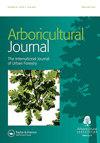当移植裸根时,大树生长得更快
Q3 Agricultural and Biological Sciences
引用次数: 1
摘要
大树裸根移植已经有几个世纪了,由于空气挖掘工具减少了所需的劳动力,这种方法再次被更频繁地使用。用裸根树移动的木本根系的直径可以是标准土壤球的两倍多,相当于根系数量的五倍。在被移栽的树木可以被认为在新的位置上生根之前,在挖树时失去的根必须被替换。移动如此大一部分的木本根系使得树木的生长更依赖于替换细根,而不是替换木本根系的生长,这对于大树来说可能需要很多年的时间。在移栽后的第二季,无论大小大小,白云杉(Picea glauca)、伦敦松(Platanus x acerifolia)、榆木(Ulmus parvifolia)和泽尔科(zelcova serrata)的生长均恢复正常或更大,平均胸径在13至28厘米之间。使用这种方法需要大量的经验,并且可能成本更高,但在某些情况下它可能是一种可行的选择。本文章由计算机程序翻译,如有差异,请以英文原文为准。
Large trees establish more rapidly when transplanted bare root
ABSTRACT Large trees have been transplanted bare root for centuries, and the method is again being used more frequently as air excavation tools have reduced the labour required. The diameter of the woody root system moved with a bare root tree can be more than twice that of a standard soil ball, representing as much as five times the amount of root system. Roots lost when the tree is dug must be replaced before a transplanted tree can be considered established in its new location. Moving such a large portion of the woody root system makes establishment more dependent on replacement of the fine roots, rather than replacing the spread of the woody root system, which can take many years for large trees. With establishment dependent primarily on fine root replacement, which can take place in the first season, growth of white spruce (Picea glauca), London plane (Platanus x acerifolia), lacebark elm (Ulmus parvifolia) and zelcova (Zelcova serrata), ranging from 13 to 28 cm average DBH, all returned to normal, or greater, in the second season after transplanting, regardless of size. Using this method requires considerable experience, and may be more costly, but it may be a viable option for some situations.
求助全文
通过发布文献求助,成功后即可免费获取论文全文。
去求助
来源期刊

Arboricultural Journal
Agricultural and Biological Sciences-Agronomy and Crop Science
CiteScore
2.40
自引率
0.00%
发文量
28
期刊介绍:
The Arboricultural Journal is published and issued free to members* of the Arboricultural Association. It contains valuable technical, research and scientific information about all aspects of arboriculture.
 求助内容:
求助内容: 应助结果提醒方式:
应助结果提醒方式:


